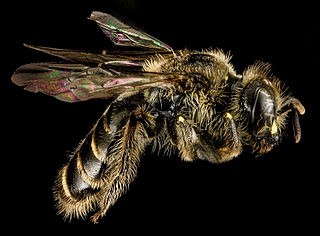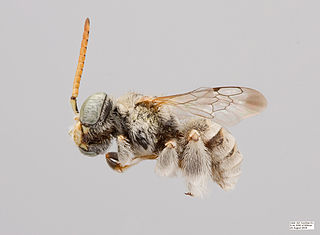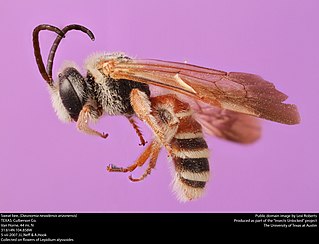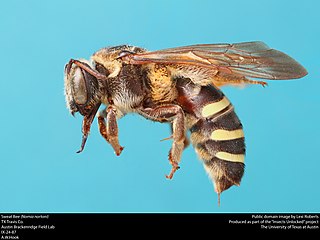
Halictidae is the second-largest family of bees with nearly 4,500 species. They are commonly called sweat bees, as they are often attracted to perspiration. Halictid species are an extremely diverse group that can vary greatly in appearance. These bees occur all over the world and are found on every continent except Antarctica. Usually dark-colored and often metallic, halictids are found in various sizes, colors and patterns. Several species are all or partly green and a few are red, purple, or blue. A number of them have yellow markings, especially the males, which commonly have yellow faces, a pattern widespread among the various families of bees. The family is one of many with short tongues and is best distinguished by the arcuate basal vein found on the wing. Females in this family tend to be larger than the males. They are the group for which the term 'eusocial' was first coined by entomologist, Suzanne Batra.

The alkali bee, Nomia melanderi, is a ground-nesting bee native to deserts and semi-arid desert basins of the western United States. It was described by Theodore Dru Alison Cockerell in 1906. While solitary, these bees nest near each other and can form extremely dense aggregations in areas with favorable conditions.

Nomia is a genus of sweat bees in the family Halictidae. Many species have opalescent bands on the metasoma. Nomia species are moderate-sized bees that nest in the ground. Most species nest solitarily, but some species also nest communally where females share a nest but where there are no queen or worker castes. Nomia species are found Africa, tropical Asia, Australia, and in North America. There are about 130 species world wide.

Calliopsis is a genus of panurgine bees in the family Andrenidae. There are over 80 described species distributed throughout the western hemisphere.

Sphecodes is a genus of cuckoo bees from the family Halictidae, the majority of which are black and red in colour and are colloquially known as blood bees. Sphecodes bees are kleptoparasitic on other bees, especially bees in the genera Lasioglossum, Halictus and Andrena. The adults consume nectar, but because they use other bees' provisions to feed their offspring they do not collect pollen.

Nomia tetrazonata is a species of sweat bee in the family Halictidae. It is found in Central America and North America.

Svastra is a genus of long-horned bees in the family Apidae. There are at least 20 described species in Svastra.

Ashmeadiella is a genus of bees in the family Megachilidae. There are more than 60 described species in Ashmeadiella.

Dieunomia heteropoda is a species of sweat bee in the family Halictidae. It is found in Central America and North America.

Nomiinae is a subfamily of sweat bees in the family Halictidae. There are about 11 genera and at least 550 described species in Nomiinae.

Anthidiellum is a genus of rotund resin bees in the family Megachilidae. There are more than 60 described species in Anthidiellum.
Dieunomia triangulifera is a species of sweat bee in the family Halictidae. It is found in the central United States from central Illinois and Minnesota westward to Utah and southern New Mexico. Adult Dieunomia triangulifera closely resemble Dieunomia nevadensis, specifically Dieunomia nevadensis arizonensis.

Xenoglossa is a genus of large squash bees in the family Apidae. There are about 11 described species in Xenoglossa.

Anthophorula is a genus of bees in the family Apidae. There are more than 60 described species in Anthophorula.

Xeralictus is a genus of sweat bees in the family Halictidae. There are at least three described species in Xeralictus.

Panurginus is a genus of bees in the family Andrenidae. There are more than 50 described species in Panurginus.

Dieunomia nevadensis, the Nevada nomia, is a species of sweat bee in the family Halictidae. It is found in Central America and North America. It was first described by Ezra Cresson in 1874.

Nomia nortoni is a species of sweat bee in the family Halictidae. It is found in Central America and North America.

Homalictus is a subgenus of bees in the genus Lasioglossum subfamily Halictinae of the family Halictidae. They are found in Sri Lanka, Southeast Asia, east across the Pacific to the Mariana Islands, Samoa, Fiji and are most prevalent in Australia.


















